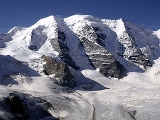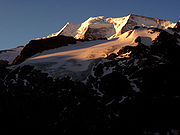
Piz Palü
Encyclopedia
Piz Palü is a mountain
in the Bernina Range
in Switzerland
and Italy
. There are three summits on its main ridge, which runs from east to west. The name Palü derives from the Latin palus, meaning a swamp, and the mountain is said to be named after the Alpe Palü, a high alpine pasture some 4 km to its east.
king of the Bernina'), who were under the impression that this was the highest summit of the mountain. This is still the normal route from Switzerland, be it followed by an easy traverse to the central peak. A second ascent of the east summit was made on 24 July 1864 by Edward N. Buxton, W.F. Digby, William Edward Hall, J. Johnston, and Montagu Woodmass with the Pontresina
guides Peter Jenny, Alexander Flury, and J. B. Walther. This group was unaware of the ascent almost 30 years earlier and also believed to have reached the highest summit (they had no vision on the summit). Approaching from the Italian (south) side, four weeks later (17 August 1864) D. W. Freshfield, J. D. Walker and R. M. Beachcroft with the guide François Devouassoud climbed the pass between the central and east summits, but chose to climb the latter peak again..
It is uncertain when the central and highest peak ("Muot da Palü") was first reached. Robin Collomb believes that this was in 1866 by Kenelm Edward Digby with the before mentioned guide Peter Jenny and a porter. It was certainly ascended on 28 June 1868 by A. W. Moore
, Horace Walker
and Jakob Anderegg. Just four weeks later a traerse of all three peaks were made by Herren Albert Wachler, Wallner, and George, with the guides Hans and Christian Grass on 22 July 1868.
The mountain has gained some prominence from the film The White Hell of Pitz Palu
(1929), co-directed by mountain-film
pioneer Arnold Fanck
and Georg Wilhelm Pabst
, and starring a young Leni Riefenstahl
.

Mountain
Image:Himalaya_annotated.jpg|thumb|right|The Himalayan mountain range with Mount Everestrect 58 14 160 49 Chomo Lonzorect 200 28 335 52 Makalurect 378 24 566 45 Mount Everestrect 188 581 920 656 Tibetan Plateaurect 250 406 340 427 Rong River...
in the Bernina Range
Bernina Range
The Bernina Range is a mountain range in the Alps of eastern Switzerland and northern Italy. It is considered to be part of the Central Eastern Alps. It is one of the highest ranges of the Alps, covered with many glaciers. Piz Bernina , its highest peak, is the most easterly four thousand-metre...
in Switzerland
Switzerland
Switzerland name of one of the Swiss cantons. ; ; ; or ), in its full name the Swiss Confederation , is a federal republic consisting of 26 cantons, with Bern as the seat of the federal authorities. The country is situated in Western Europe,Or Central Europe depending on the definition....
and Italy
Italy
Italy , officially the Italian Republic languages]] under the European Charter for Regional or Minority Languages. In each of these, Italy's official name is as follows:;;;;;;;;), is a unitary parliamentary republic in South-Central Europe. To the north it borders France, Switzerland, Austria and...
. There are three summits on its main ridge, which runs from east to west. The name Palü derives from the Latin palus, meaning a swamp, and the mountain is said to be named after the Alpe Palü, a high alpine pasture some 4 km to its east.
History
As early as 12 August 1835, the 3,883 m east peak was climbed by Oswald Heer, and Peter and M. Flury, with guides Johann Madutz and Gian Marchet Colani (the 'chamoisChamois
The chamois, Rupicapra rupicapra, is a goat-antelope species native to mountains in Europe, including the Carpathian Mountains of Romania, the European Alps, the Tatra Mountains, the Balkans, parts of Turkey, and the Caucasus. The chamois has also been introduced to the South Island of New Zealand...
king of the Bernina'), who were under the impression that this was the highest summit of the mountain. This is still the normal route from Switzerland, be it followed by an easy traverse to the central peak. A second ascent of the east summit was made on 24 July 1864 by Edward N. Buxton, W.F. Digby, William Edward Hall, J. Johnston, and Montagu Woodmass with the Pontresina
Pontresina
Pontresina is a municipality in the district of Maloja in the canton of Graubünden in Switzerland.-History and name:The city was first mentioned in medieval Latin documents as pontem sarasinam in 1137. In 1237 it was mentioned as de Ponte Sarraceno and in 1303 as ponte sarracino...
guides Peter Jenny, Alexander Flury, and J. B. Walther. This group was unaware of the ascent almost 30 years earlier and also believed to have reached the highest summit (they had no vision on the summit). Approaching from the Italian (south) side, four weeks later (17 August 1864) D. W. Freshfield, J. D. Walker and R. M. Beachcroft with the guide François Devouassoud climbed the pass between the central and east summits, but chose to climb the latter peak again..
It is uncertain when the central and highest peak ("Muot da Palü") was first reached. Robin Collomb believes that this was in 1866 by Kenelm Edward Digby with the before mentioned guide Peter Jenny and a porter. It was certainly ascended on 28 June 1868 by A. W. Moore
Adolphus Warburton Moore
Adolphus Warburton Moore was a British civil servant and mountaineer.-Life:The son of Major John Arthur Moore and Sophia Stewart Yates,, Moore was an India Office official from 1858–1887, holding the role of Assistant Secretary, Political Department from 1875–1885...
, Horace Walker
Horace Walker
Horace Walker was an English mountaineer who made many notable first ascents, including Mount Elbrus and the Grandes Jorasses.-Alpinism:...
and Jakob Anderegg. Just four weeks later a traerse of all three peaks were made by Herren Albert Wachler, Wallner, and George, with the guides Hans and Christian Grass on 22 July 1868.
The mountain has gained some prominence from the film The White Hell of Pitz Palu
The White Hell of Pitz Palu
The White Hell of Pitz Palu is a 1929 silent mountain film directed by Arnold Fanck and Georg Wilhelm Pabst and starring future filmmaker Leni Riefenstahl and World War I flying ace Ernst Udet.-Plot:...
(1929), co-directed by mountain-film
Mountain film
A mountain film is a film genre that focuses on mountaineering and especially the battle of man against nature. In addition to mere adventure, the protagonists who return from the mountain come back changed, usually gaining wisdom and enlightenment....
pioneer Arnold Fanck
Arnold Fanck
Arnold Fanck was a pioneer of the German mountain film....
and Georg Wilhelm Pabst
Georg Wilhelm Pabst
-Biography:Pabst was born in Raudnitz, Bohemia, Austria-Hungary , the son of a railroad employee.Returning from the United States, he was in France when World War I began...
, and starring a young Leni Riefenstahl
Leni Riefenstahl
Helene Bertha Amalie "Leni" Riefenstahl was a German film director, actress and dancer widely noted for her aesthetics and innovations as a filmmaker. Her most famous film was Triumph des Willens , a propaganda film made at the 1934 Nuremberg congress of the Nazi Party...
.
External links
- Piz Palü on SummitPost
- Synopsis, production credits and cast of The White Hell of Pitz Palu (in English)


